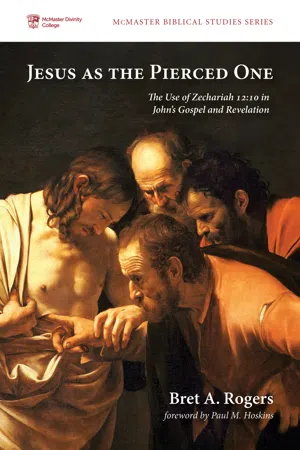![]()
1
Introduction
Zechariah 12:10 stands as an obscure prophecy for interpreters of Scripture, whether ancient or modern. Beyond the diverse reception-history, text-critical problems, unusual grammar, and contextual ambiguities, the challenging question remains, “Who shall we say Zechariah’s Pierced One is?” The Apostle John apparently finds resolution to Zechariah’s prophecy in the person and mission of Jesus, referencing it once for Jesus’ ignominious death (John 19:37) and again for Jesus’ glorious return (Rev 1:7). Yet for all the mounting scholarship devoted to the NT writers’ use of the OT, including John’s use of Zechariah in particular, no in-depth treatment exists for how John’s use of Zech 12:10 builds on an understanding of Jesus’ divine identity in his eschatological mission, especially when considered in light of a joint study of John 19:37 and Rev 1:7.
Thesis
This study will examine how John’s use of Zech 12:10 builds on an understanding of God’s self-disclosure in Jesus’ two-fold eschatological mission. John 19:37 will provide the initial insight to how God’s self-disclosure in Jesus enables John to link the piercing of Jesus’ side with the fulfillment of Zechariah’s puzzling promise that people will somehow pierce Yahweh. Revelation 1:7 will then give further insight to how God’s self-disclosure in Jesus enables John to maintain the eschatological elements of Zechariah’s prophecy such that Jesus’ piercing is both prerequisite for and fundamental to God’s eschatological work. The purpose in bringing John 19:37 and Rev 1:7 into a single study is to demonstrate that God’s self-revelation in Jesus appears to provide John the interpretive key that unlocks the mysterious promise of Zech 12:10. Considering the piercing of Jesus, whom John presents as God the Son incarnate, it becomes apparent how God receives the piercing as part and parcel to his eschatological work of salvation.
In order to pursue such a thesis, two major objectives stand in the way. First, it is necessary to investigate the identity of the Pierced One in Zech 12:10 and demonstrate the validity of understanding the Pierced One’s identity as more than a human representative of Yahweh but as Yahweh himself. This first objective will also help gauge whether John imposes onto Zech 12:10 a meaning that was never present, or imports from Zech 12:10 a meaning that was justifiably always present yet hidden until God’s final self-disclosure in Jesus Christ.
Second, I must investigate how the apostle John uses Zech 12:10 in the Fourth Gospel and Revelation in order to help his readers understand the Christological and eschatological significance of Jesus’ crucifixion and return. Sound exegesis will demand giving adequate attention to the immediate contexts of John 19:37 and Rev 1:7 as well as to the broader narrative elements John employs for his theological presentation within each book. Also, a careful consideration of John’s hermeneutical presuppositions will transpire in determining John’s exegetical warrant for appropriating Zech 12:10 to explain Jesus’ death and return the way he does. Inevitably, our study must also answer how and why John appropriates the same OT text for two separate events in Jesus’ eschatological mission, his death and his return.
Pursuing the aforementioned thesis aligns with other contributions surrounding the NT writers’ use of the OT, especially those related to the use of Zechariah. Indeed, the following investigation into John’s use of Zech 12:10 even finds precedent as far back as Justin Martyr (Dial. 32.2; cf. 1 Apol. 52.11–12). Nevertheless, the following study will contribute to the field of NT studies in at least four ways.
First, I will argue that identifying the Pierced One as Yahweh is a credible and defensible reading of Zech 12:10. Even the Jewish and Christian interpretations that, in my estimation, rightly understand Zech 12:10 along lines of future messianic hope inadequately explain the piercing of Yahweh, since they restrict the piercing to Yahweh’s human messianic representative. Second, I will argue that John’s use of Zech 12:10 to explain Jesus’ identity and mission is credible, because Zechariah identifies Yahweh as the Pierced One and not merely with the Pierced One, a notion previous studies regularly overlook but which aligns well with John’s development of God’s self-disclosure in Jesus. Third, ...
